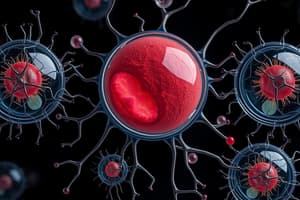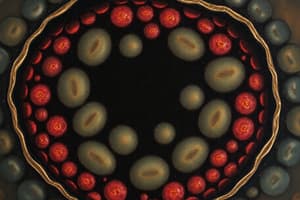Podcast
Questions and Answers
What are the components of cell theory? (Select all that apply)
What are the components of cell theory? (Select all that apply)
- All living things are made up of cells (correct)
- Cells carry genetic information in the form of RNA
- Cells are the smallest units of life (correct)
- All cells come from pre-existing cells (correct)
Why do eukaryotic cells have membrane-bound organelles?
Why do eukaryotic cells have membrane-bound organelles?
Allows for compartmentalization of functions which allows for specialization.
What does the nucleus contain?
What does the nucleus contain?
All the necessary genetic material for replication of the cell.
What is the nucleolus?
What is the nucleolus?
What are genes?
What are genes?
Describe mitochondrial division and function.
Describe mitochondrial division and function.
How do mitochondria replicate?
How do mitochondria replicate?
What do lysosomes contain?
What do lysosomes contain?
What is the role of the endoplasmic reticulum?
What is the role of the endoplasmic reticulum?
What is the rough endoplasmic reticulum?
What is the rough endoplasmic reticulum?
What is the smooth endoplasmic reticulum?
What is the smooth endoplasmic reticulum?
What is the function of the Golgi apparatus?
What is the function of the Golgi apparatus?
What is the cytoskeleton?
What is the cytoskeleton?
What are microtubules?
What are microtubules?
What are microfilaments?
What are microfilaments?
What are intermediate filaments?
What are intermediate filaments?
What do peroxisomes contain?
What do peroxisomes contain?
Are viruses considered living organisms?
Are viruses considered living organisms?
What is the point of membrane-bound organelles?
What is the point of membrane-bound organelles?
What is synthesized in the nucleolus?
What is synthesized in the nucleolus?
Flashcards are hidden until you start studying
Study Notes
Cell Theory
- All living organisms consist of cells.
- Cells are the basic structural and functional units of life.
- New cells arise only from pre-existing cells through division.
- Cells carry genetic information as DNA, transmitted from parent to daughter cells.
Eukaryotic Cells
- Possess membrane-bound organelles for compartmentalization, enhancing specialization of cellular functions.
Nucleus
- Houses genetic material essential for cell replication.
- Enclosed by a nuclear membrane, separating it from the cytoplasm.
- Contains nuclear pores for selective exchange between the cytoplasm and nucleus.
Nucleolus
- Site of ribosomal RNA (rRNA) synthesis within the nucleus.
Genes
- Defined as coding regions within DNA that direct the synthesis of proteins.
Mitochondria
- Surrounded by an outer membrane acting as a barrier and an inner membrane folded into cristae, housing enzymes for the electron transport chain.
- Contains intermembrane space and mitochondrial matrix.
- Replicate independently via binary fission, possessing their own genetic material.
Lysosomes
- Contain hydrolytic enzymes for breaking down various substrates.
- Work with endosomes to transport and sort cellular materials.
Endoplasmic Reticulum (ER)
- A membrane system aiding in protein and lipid production, processing, and transport.
Rough Endoplasmic Reticulum (RER)
- Studded with ribosomes, responsible for assembling proteins for transport.
- Directly translates proteins destined for secretion into its lumen.
Smooth Endoplasmic Reticulum (SER)
- Lacks ribosomes; synthesizes lipids, regulates calcium levels, and detoxifies substances.
- Transports proteins from RER to the Golgi apparatus.
Golgi Apparatus
- Membrane system that modifies and packages proteins for cellular export.
Cytoskeleton
- Provides structural support and maintains cellular shape.
- Facilitates transport within the cell through three components: microfilaments, microtubules, and intermediate filaments.
Microtubules
- Hollow rods made of tubulin proteins; key for cell shape and movement.
- Serve as tracks for motor proteins like kinesin and dynein to transport vesicles.
Microfilaments
- Composed of actin, forming networks that resist compression and fracture.
- Involved in muscle contraction and cytokinesis through their interaction with myosin.
Intermediate Filaments
- Made of various filamentous proteins (keratin, desmin, vimentin, lamins).
- Provide rigidity, help with cell adhesion, and anchor organelles.
Peroxisomes
- Contain enzymes that produce and degrade hydrogen peroxide.
- Break down long-chain fatty acids via beta-oxidation and participate in phospholipid synthesis.
Viruses
- Classified as non-living because they cannot reproduce independently and often contain RNA as their genetic material.
Importance of Membrane-Bound Organelles
- Compartmentalization allows for distinct cellular functions and processes.
- Organelle membranes are primarily composed of a phospholipid bilayer.
Studying That Suits You
Use AI to generate personalized quizzes and flashcards to suit your learning preferences.




